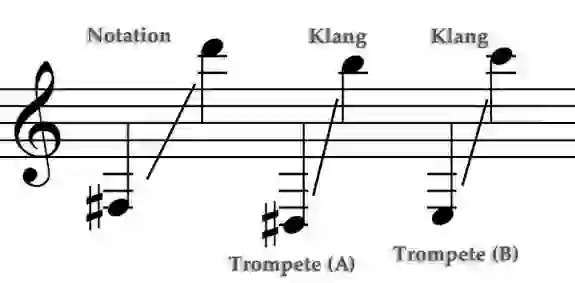Notation and sound generation » Trumpet » Philipp Dangas
Notation and sound generation of the Trumpet
The modern trumpet is a transposing instrument in Bb and in A. The "trumpet in Bb" in classical scores means the low Bb trumpet, to be distinguished from the valve trumpet in high Bb that is often blown today. There isn't one either transposing trumpet in C.
The trumpets in Bb and in A are actually not 2 different instruments, but one: A Bb trumpet is converted into an A trumpet by extending the tuning slide and thereby increasing the overall length of the instrument. The trumpet in C, on the other hand, is an instrument in its own right. The main difference between the "old" and the "new", i.e. the natural and the valve trumpet, is that the modern (valve) trumpet is a much smaller instrument. Its fundamental tone is exactly one octave higher than that of the "old" trumpet. The treble clef is used for the notation of the trumpet.
The trumpet in the classical orchestra is generally played in pairs. The stop has the same effect on the trumpet as on the horn in F, and a range of overtones can be achieved. The tonal impairment is even greater than with the horn. The tones lose their characteristic trumpet sound. For this reason, the classical composition dispenses almost entirely with the demand for stuffed tones on the trumpet. The domain of the trumpet, with its bright, penetrating timbre, is the fanfare. Tone repetitions in marked rhythms, broken triads, sustained tones and accents are their tasks.
Download size: 784 kilobytes
Table summary of playing techniques on the trumpet
The following table lists the playing techniques and playing effects on the trumpet shown. The playing techniques that are not suitable are also briefly mentioned.

The range of a trumpet in large scale
Internal search function
| Name | Value | Delete |
|---|